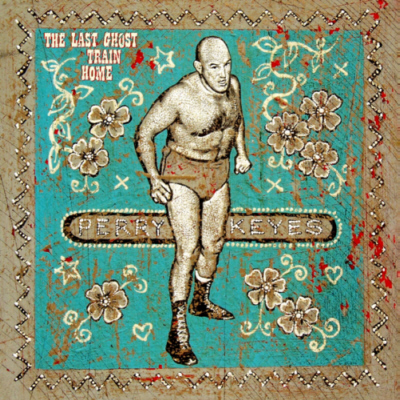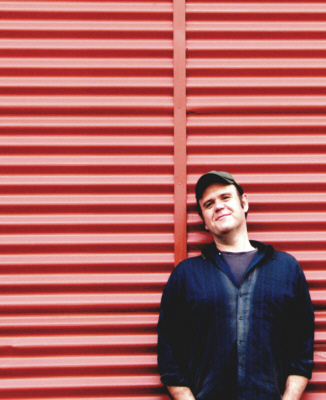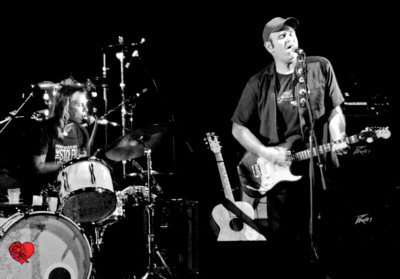
Perry Keyes
"The Last Ghost Train Home"
by Johanna J. Bodde

|
PERRY KEYES "The Last Ghost Train Home" (Laughing Outlaw Records) To tell you the truth, I'm now already looking
forward to playing "NYE" from "Meter" again in December! When "Meter" was
released in 2005, Perry Keyes was compared to Springsteen. As reviewers often
do, when somebody writes storysongs situated in blue collar neighbourhoods,
playing them in a quite rocking way. It's not so bad to be compared with the
early Springsteen though, it's an honor, as I never forget the country's
toughest DJ literally sobbing on the air, after playing "Meeting Across The
River", as it's so true and so damned beautiful. But... how convincing is a
multi-millionaire these days? And Perry is convincing and most definitely for
real! There's only one way to find out if a
singer-songwriter is for real, when he comes up with something about working
class heroes. Ask him or her to describe the smell... How did their father and
big brother and uncle and neighbour smell, when they came home from a night
shift at the factory or the ships repair yard or the blast-furnace plant?
There's something so undeniable in that smell of oil, tar, grease and sweat!
Hey, maybe it even comes off this new CD by Perry Keyes!
Some background info, quoted from his bio: Perry
has been writing songs since he was a kid and has played in a variety of bands.
Most notably, in the late eighties, he fronted "Perry Keyes and the Stolen
Holdens" a band which everybody had heard of, but no one actually saw. Mark that
down as just another of the many mistakes, made growing up.
No other Australian songwriter is writing about
Matraville, the Barbeque King, the abandonment of working class suburbs or the
way a kid loves a footy player - few other Australian songwriters are writing
about anything with such honesty, heart or insight.
The world Keyes sings about is one of growing up in
the Sydney neighbourhoods of Redfern and Waterloo, of embracing the working
class culture that dominated the inner-city in those days, and of family. Of
being at one with the winners and losers lurking at the TAB, the local pub and
greasy spoon, the rugby league, the speedway, the boxing. Of chancing your arm
amid the tawdry but endlessly romantic neon glitter of the Easter Show. Of love
and drugs, sleeping rough and risking being incarcerated for things you may or
may not have done. Of busting a gut driving a cab or slaving in a factory from
dawn to dark to pay the rent, maybe buy the new Clash record and a feed of beef
and black bean on Friday night with your best girl.
Keyes's scenes and rich gallery of characters are
photograph-vivid and anointed with acutely-observed and brutally-honest detail
that brings them roaring to life. His images and anecdotes, some poignant,
others the stuff of nightmares, loom at you like sylphs and hellions from a
ghost train gloom.
Once again, Keyes is backed by his band, Give My
Love To Rose, featuring Edmond Kairouz on guitars and vocals, Earl Pinkerton on
bass, and the extraordinarily talented Bek-Jean Stewart on drums and shimmering
back-up vocals that tingle the spine. She recently released her own excellent
and intriguing album "Junior Years". And Michael Carpenter, a familiar name on
records by Australian artists, is also credited for some playing and recording.
Oh yes, the front cover painting is made by Jon
Langford, figuring that out takes only one glance!
I listened, like this was a long and spell-binding
story, divided in several chapters. A gritty, realistic and yet poetic story.
The kind of story cabdrivers and those other kids from working class
families know all too well... Memories coming back: when the big whistle
blew, go and wait for Dad, who walked through the factory gate smoking his
self-rolled cigarette. And this story also features such grrreat
music!!
--- Written by Johanna J. Bodde, September 2007
---
 And how about the rabbit killers in old Ford |
 SIDESHOW ALLEY "This was the main thoroughfare that ran through
the middle of the carnival section of the Easter Show. It had all the usual
stuff - Ghost Train, House Of Mirrors, Fortune Tellers, Headless Lady, a half
boy-half chicken and the Boxing Tent. Tom Waits would've loved it!! Driver
Avenue is the main road that runs along side the Sydney Cricket Ground and the
Show Grounds. Tens of thousands of people would fill this road whenever there
was something on. When I was a kid, this stretch had a number of old wooden bus
stops and they were often filled with men & women who would sleep and drink
in them until the cops moved them on." Who was Ronald Ryan? "He was the last man
hanged in Australia. His impending and subsequent execution caused a great
outcry and still resonates today. I thought using his name for the main
character in this song was kind of apt."
PETER COTTONBALL
"Prince Alfred Park Municipal Swimming Pool is a
council swimming pool that's situated inside a huge park that runs alongside
Cleveland Street and down to Central Railway Station. The back area of the pool
would slope down towards the train tracks that run along the back of the park.
Once a week, council workers would clean out the needles and broken bottles that
littered the area. When I was 17 I had a girlfriend and we would lay on this
slope and watch the trains rushing by while we drank beer... The songs 'N.Y.E.'
and 'Bonfires Of June' from 'Meter' are about her and that time. My high school
had this whole area as its playground - it was somethin' else!" And there are
cars mentioned? "Muscle Cars! Every year there was a motor show at the Show
Grounds. It was where you could go and see all the latest car stuff and get your
photo taken in the Batmobile!! The Holden Torana XU1 is an iconic Australian
muscle car of the 1970's, while the Ford GTO is an iconic American muscle car of
the 1970's." And sportsmen? "The Bomber Man (Footy player John Peard) and The
Galloping Ghost (Footy player Brian Bevan). Sportsmen with nicknames always
seemed a helluva lot more interesting than other players to me when I was a kid.
Maybe now, too." And a train station? "Central Railway Station, Sydney's largest
railway station. Built on a cemetary, it has 27 platforms. Central Station
Tunnel is an underground thoroughfare that enabled you to walk from one side of
Central Station to the other. There's always a lot of busking going on down
there. I've never busked, though Joe Strummer seemed to be into it quite a
bit."
AT THE SPEEDWAY
"The Sydney Showground Speedway is no longer there. Sidecars, midget
racers, hot rods and smash up derbys!!! As the area around the Show Grounds
became gentrified, less people appreciated the value of a place like the
Speedway. It was quite a thing, though. The floodlights, the track announcer's
frantic exaltations and the noise of the bikes & cars would spill across the
adjacent streets. Just like the people who once flocked to it, The Speedway was
shifted out west." The Olivia Newton-John song "Down By The Banks Of The Ohio"
is mentioned? "My Dad would take me and my brother on drives on Saturday nights
when we were kids and this is the sort of stuff they would play on the radio in
between the greyhound races. TAB Tickets were betting slips. If my Dad had a
good day on the 'punt' (gambling on horse racing) he would take my Mum, my two
brothers and myself out, invariably, to a Chinese restaurant. If he didn't do so
well, we'd stay home and watch Hawaii-Five-O. The Canton Cafe was a Chinese
restaurant on Botany Rd in Redfern. The pre-eminent Chinese restaurant where I
grew up. Situated next to the local TAB, winners and losers alike would seat
themselves behind a formica top table in a cramped booth and enjoy everything
from the more up-market Prawn and Pork Combination Omelette to the Losers
Special - chips & gravy with a small fried rice. When I inevitably die of
heart disease this establishment will have been primarily responsible for my
(and many others) early death." And a few references to music: "Django
Rheinhardt, a Belgian Gypsy who could play guitar with just two fingers. Concise
as it may be, this is hardly an adequate description of Django. The Gibson
Flying V guitar, a guitar that came to prominence when Jimi Hendrix, among
others, started using one. The first guy who I ever started a band with stole
one from a guitar shop on Cleveland Street. He was a drummer... but he loved
playing Van Halen riffs on his Flying V. 'Space Truckin' is a Deep Purple song
off 'Machine Head' album. When I was 8 years old I had a cousin who was about 15
at the time. He told me that Deep Purple's 'Machine Head' was the 'loudest'
record ever made!! His Mother was deaf and mute so he would crank his stereo up
to the max and never get into any shit for it!! He was also into Neil Young's
'Harvest' which, when he would play it at full volume, would sound just as loud
as 'Machine Head' in parts - funnily enough."
MATTHEW TALBOT'S BLANKET
"The Matthew Talbot Hostel, since just before the
last world war this has been a shelter for homeless men in Sydney. It provides
over a quarter of a million meals a year and its beds are used almost 37,000
times a year. One night, after finishing a taxi shift -I sometimes drive a cab-,
a couple of drivers were talking about a homeless man who was found outside the
major cinema complex on Sydney's main street. He'd lain there, dead, for almost
12 hours before anyone noticed."
IN ANCIENT ROME
"I first started driving taxi cabs just before the
2000 Sydney Olympics. One of the things that struck me hardest during those
initial night shifts was the amount of kids who were sleeping rough in around
the central parts of the city. In the lead up to the Olympics the government
installed new park benches and bus stops that would make it harder for somebody
to sleep on. The Wall is an infamous stretch of road on the fringe of the red
light district. Young men lean against the sand stone wall that runs along side
Sydney's Central Criminal Court Building with their heads bowed, covered in
hoods, waiting for work from the passing cars." And how does the 1963 Ford
Fairlane fit in? "My girlfriend once hired an old vintage car for me on my
birthday and we got driven around in it with the top down - I felt a bit like
Lucy Jordan."
DALE BUGGINS DREAM
"Dale Buggins was a dare-devil stunt motorcyclist. He'd perform all around
the country, a lot of times in rural areas where not a lot of entertainers of
note would go. I remember when I was about 15 seeing a guy on the news. He was
about 40-50 years of age and he was crying. I asked who it was and my older
brother said it was Dale Buggins' Dad. It turned out that Dale had just shot
himself in a motel room in Melbourne. He was 20 years old. Dale was like
Australia's Evel Knievel. Evel was a big deal when I was a kid. Heaps of broken
collar-bones on my street... Mini-Bikes, when I was a kid it was every boys
dream to own a mini-bike. Most of us had to settle for a skate board. My little
brother 'scored' one when he was about 14. I think it came from one of the
carnivals down on the beach... he gave it back, later. The Dragstar Bicycle,
high handle-bars and a long sloping seat. This was the shit in 1975." And how
does Eli Wallach fit in here? "The western was a big deal in our house. From
'Bonanza' to 'Once Upon A Time In The West'. I always loved that scene in 'The
Good, The Bad and The Ugly' where Eli Wallach says 'We don't need no stinkin'
badges!' Where I grew up there were a lot of guys who lived that sort of
attitude. I tried to get Warren Oates into the song but I couldn't get it to
work. Maybe next time."
JOE STRUMMER
"Joe Strummer wrote the best rock'n'roll lyrics, ever. He had the biggest
rock'n'roll heart, ever. An absolute Inspiration!! 'City of The Dead' is a Clash
song title from the 'Black Market Clash' EP. Montgomery Clift, an American actor
and inspiration for The Clash song 'The Right Profile'. Arthur Scargill was the
leader of the British Miner's Union during 1985 miners strike. When the British
miners went on strike in the mid-eighties the nightly news would be full of
images of the picketing workers facing off long lines of English Bobbies...
Margaret Thatcher, Ronald Reagan and Rupert Murdoch, the Forces of Darkness had
taken hold of the reins with only Ken Loach standing in their way! In those days
I looked at the world through a naive kind of rock'n'roll filter and I remember
watching the TV and thinking - the world needs The Clash to get back together...
real quick."
THE LAST GHOST TRAIN HOME
"Every weekday during the evening rush hour around
Sydney's Central Station, thousands of commuters on their way home make their
way toward the various terminal entrances. Later in the evening, after most
people have left the city, the homeless congregate in the various parks and
thoroughfares that, just hours earlier, were teeming with commuters. The title
comes from the question - What kind of train do you catch to get home when you
no longer have a home to go to? The Clock Tower of Redfern Post Office: every
second Thursday on Redfern Street a long line forms outside the Post Office
doors as people wait to collect their welfare. And The Sky Bar, opposite Redfern
Post Office: Once paid up, a lot of folks then cross the road to play the poker
machines that, nowadays, fill up large sections of every pub in
Sydney."
===== |
